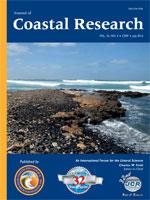Vieira da Silva, G.; Muler, M.; Prado, M.F.V.; Short, A.D.; Klein, A.H.F., and Toldo, E.E., Jr., 2016. Shoreline change analysis and insight into the sediment transport path along Santa Catarina Island north shore, Brazil.
This paper presents a shoreline change analysis applied to identify the sediment transport path involving nine adjoining beaches, including dunes and spits, located along the microtidal eastern and northern shores of Santa Catarina Island (Brazil) and extending 50 km from Barra-Moçambique to Daniela. A data set was comprised of aerial images from 1957, 1978, 1998, 2002, 2007, and 2010, and the 2012 shoreline position measured with real-time kinematic GPS, topobathymetric data set, and a 60-year water-level time series. The images were rectified and the shoreline position for each year was extracted. The average errors (ranging from 1 to 9.8 m) of the rectification process as well as the horizontal tide-related errors (varying from 8.3 ± 2.6 m to 14.9 ± 0.6 m) were calculated within a confidence level of 95%. Two complementary approaches were used: (1) general trends analysis using linear regression rate method and (2) shoreline behaviour statistically analysed by Euclidean distance and year-to-year analysis. The results indicate an anticlockwise longshore transport between a series of beaches with variable orientation and separated by headlands, including a dune overpassing from Santinho delivering ∼10,000 m3 y−1 to Ingleses, and headland bypassing leading to the development of three spits along the protected part of the study area that have possibly been nourished by subaqueous sand transport from the updrift beaches. During its development the Ponta das Canas spit grew ∼7000 m3 y−1, controlling the sediment availability downdrift. As the spit grows it traps sediment and the downdrift area retreats; on the other hand, when the spit merges to the coast the sand spreads and the downdrift beaches prograde.





